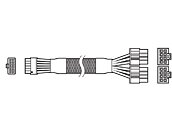Tuesday, September 8th 2020

Corsair Working On Direct 12-Pin NVIDIA Ampere Power Cable
NVIDIA Introduced a new 12-pin power connector with their RTX 30 series founder edition cards to accommodate the higher power draw. The new RTX 30-Series cards feature GPU power requirements of 220 W, 320 W, and 350 W for the RTX 3070, 3080, and 3090 respectively. The new 12-pin connector is roughly the same size as a single 8-pin PCIe connector but can provide significantly more power in that same space. NVIDIA will supply an adapter in the box to convert two 8-pin connectors to a single 12-pin connector, however this will require extra cable management and introduce another point of failure.
Corsair has announced they are developing a custom cable that will be fully compatible with all Type 3 and Type 4 CORSAIR modular power supplies to allow for a clean connection. The new cable connects two PCIe / CPU PSU ports directly to the new 12-pin connector and is currently undergoing development and testing. Corsair also now recommends a PSU rating of 850 watts or higher for the RTX 3090. The Corsair 12-pin cable should be available for sale by September 17th the same day as the RTX 30 series cards, pricing wasn't announced but you can sign up to be notified here.
Source:
Corsair
Corsair has announced they are developing a custom cable that will be fully compatible with all Type 3 and Type 4 CORSAIR modular power supplies to allow for a clean connection. The new cable connects two PCIe / CPU PSU ports directly to the new 12-pin connector and is currently undergoing development and testing. Corsair also now recommends a PSU rating of 850 watts or higher for the RTX 3090. The Corsair 12-pin cable should be available for sale by September 17th the same day as the RTX 30 series cards, pricing wasn't announced but you can sign up to be notified here.


51 Comments on Corsair Working On Direct 12-Pin NVIDIA Ampere Power Cable
www.corsair.com/us/en/psu-cable-compatibility
Good job.
What it seems to boil down to is that any modular Corsair PSU released within the last half decade will be able to accept this new cable.
Most mid range psus and even many high end psus simply were not designed for that much being drawn from a single port, they were built with the expectation that port would feed an 8pin and 6pin combo at most (225w). Hence Corsair only recommending their beefiest Psus for the job.
This caused superflower headaches a number of years ago when they put two 6+2 connectirs on the same cable to give customers flexibility on which they used as the 8pin, and some used both as the 8pin and burned the PSU connector.
Corsair are proberbly looking to avoid that happening (or looking at avoiding the RMAs) by warning against using the 12pin adaptor with a 3090 on a weaker psu.
Ive edited it now to make it a little more obvious in case anyone else misreads.
Cripes, people on the Internet really don't read, do they?
The 8-pin outputs of a Corsair PSU can put out as much, or in some cases even more, than anyone else's PCIe ports. The problem is, you have a connector with a potential power delivery of 648W. Not that the cards will necessary need that, but it's an unknown right now (only synthetic numbers have come from Nvidia). 750W is recommended by Nvidia, but it doesn't leave much head room. I PERSONALLY think that 750W will be fine for most people, but there are some in the office that think when paired with certain CPUs it won't be and want to side with caution.
I am a little worried about Nvidia's included adapters, however. It can adapt either an EPS12V or PCIe to the 12-pin. While mechanically, an 8-pin can deliver 336W, and that's why a lot of PSUs put two PCIe on one cable... because 2x PCIe on paper should only need to deliver 300W (2x 8-pin @ 150W each), if you go beyond that, you WILL see a drop in voltage. That's not because of the PSU, the pins, etc. but because of the wire. Even using 14g wire you're going to see a drop that could impact the graphics card's performance. That's why even with the 2080 Ti, it was often suggested to use two PCIe CABLES and not just two PCIe CONNECTORS (photo credit Seasonic:
While that suggestion is still widely supported, anyone that's frequently read these forums or Reddit knows that a lot of users aren't smarter than the average bear and will use just one cable "because". Apparently, they're also not teaching Ohm's law in compulsory education any more and a lot of people simply don't know V = I * R.
Also, I know about excessive ratings, but for Corsair to take Nvidia's recommended 750w and upgrade it to 850w is unusual I think.
Though, I will say that if it WAS an actual "Y split" there would be less issues because there would be more conductors to carry the current (from the split to the load). But alas, everyone does go from one 6+2 to a second on a little pigtail and that's where the problem lies. All of the load for both connectors is on the wires going to the first connector.Yeah. Someone on the systems team did a test build using all high end parts and didn't feel comfortable with the 750W recommendation. That said, my guys are testing to the synthetic numbers Nvidia provided... you know.. since they JUST PROVIDED THEM LAST WEEK, even though the card has been in dev for months and Corsair is literally an Nvidia part under NDA (FFS).And yet the chart says, in plain English, "The only difference between Type 3 and Type 4 cables is the pinout of the 24-pin ATX cable; all other cables (SATA, PCIe, etc) are the same."
So to point out that 3 and 4 are the same except for the 24-pin and the point out the 24-pin is different is needlessly confusing? ;)
The reason they don't all say "Type 4" is because Type 3 came out before Type 4. The cables are actually LABELED. It's not just some arbitrary designation only found on a cable compatibility website. PSUs that came out before Type 4 all say "Type 3" on the cable connector that plugs into the PSU. So if you said they were all Type 4 and ignored that Type 3 existed in the first place and then gave someone a Type 3 cable from an older PSU, even if it's for an older PSU, they'd probably just go "nope... won't work" just based on how the cable is labeled.
EVGA T2:
Seasonic Prime:
And yes that is exactly what I have.
I probably am just confused on terminology here.
A "Y" would be when there's a split into two separate cables out of one, like the letter "Y".
Like this: